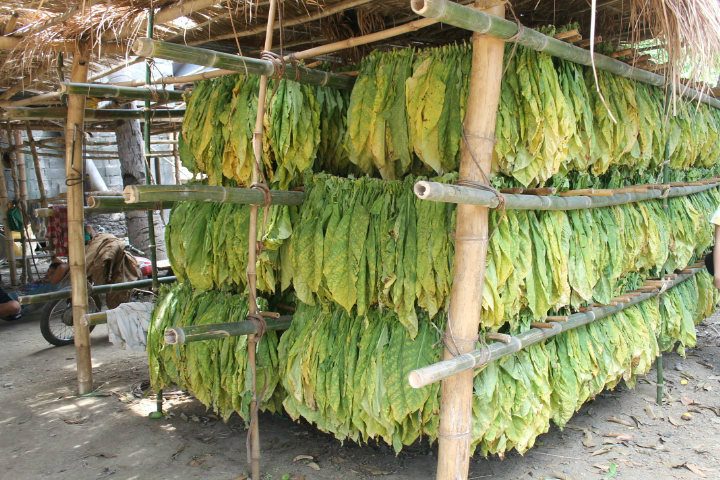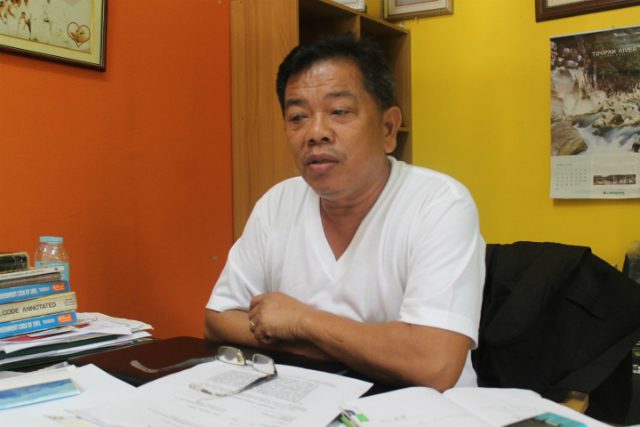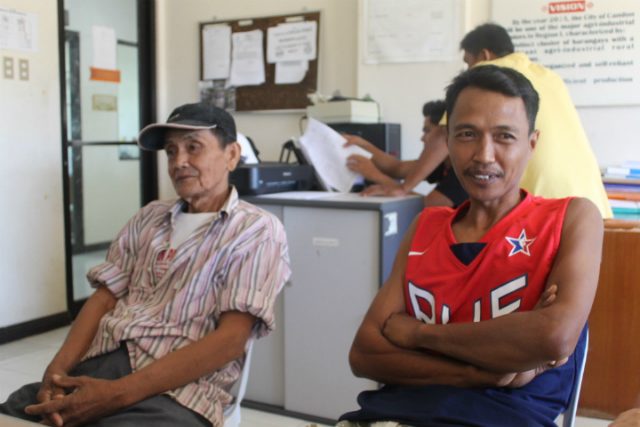SUMMARY
This is AI generated summarization, which may have errors. For context, always refer to the full article.

READ: Part 1: What local governments owe tobacco farmers
ILOCOS SUR, Philippines – Despite the Philippines’ local and international commitments to shift farmers to alternative crops and alternative livelihood, the city of Candon in Ilocos Sur is aggressively encouraging farmers who are already growing other crops like corn to go back to tobacco.
The city’s motivation? Republic Act (RA) 7171, or the law that allots 15% of collections from excise taxes on locally manufactured Virginia type of cigarettes to be distributed among Virginia tobacco-producing provinces.
In 2016, Candon City – dubbed the “Tobacco Capital of the Philippines” – received the highest share from RA 7171 – P356.86 million, according to the Department of Budget and Management Local Memorandum 72.
Local officials are worried that the “drastic regression” in the number of hectares in the city planted to tobacco would result to a lower share of funds from RA 7171 in the coming years.
According to the city government, only 684.61 hectares of farmland were planted to tobacco in 2016 – a drop from the 1,007 hectares in 2015.
“One of the primary reasons was the punishing high cost of farm inputs,” read a document from the local government. It proposes to increase tobacco production again in the city through “fertilizer and pesticide amelioration.”
City Councilor Robert Tudayan told Rappler that many of their farmers have shifted from tobacco to corn and peanut because of the “campaign against cigarette smoking.”
In addition, some farmers were dismayed with the pricing of tobacco. Tudayan said there were instances when the tobacco leaves that came from a single curing barn were graded differently, and thus, priced differently as well at the trading centers.
But many farmers in Candon planted corn instead of tobacco for two reasons, according to Tudayan: they were encouraged by the “Outstanding Quality Corn Achiever Award” that Ilocos Sur won in 2016, and the provincial government provided them with free corn seeds.
“Noong medyo umiikot na ‘yung mga sa agriculture namin, nakita na nila na natanim na ‘yung mga dating tinatamnan ng tobacco, marami nang mais,” he explained.
(When our people from the agriculture office were already going around, they saw that many of the lands that used to be for tobacco were already planted with corn.)
But with more farmers planting corn, prices of the crop have dropped to P12.20 per kilo. City agricultural officer Elmor Leaño said that, at this rate, if a farmer produced 5,000 kilos per hectare, “ang nabawi mo lang ‘yung puhunan mo (you’ve only earned what you invested).”
“Kaya maraming nag-aano ngayon na, ‘Dapat hindi na kami nag-shift sa [corn], nag-tobacco na lang kami.’ Siguro, itong next cropping season ng tobacco, dadami’t dadami ‘yang farmers namin,” he said.
(That’s why many farmers are thinking, “We should not have shifted to corn, we should have planted tobacco instead.” Maybe this next cropping season of tobacco, the number of tobacco farmers will go up.)
Figures from the agriculture office showed there are about 669 tobacco farmers in Candon City.

Incentives
Still, the city government is doing everything it can to encourage farmers who have shifted to go back to tobacco farming.
“Kasi dahil sa 7171,” Leaño answered when asked why they want farmers to go back to tobacco. “Kasi sa peanut ‘tsaka sa corn, walang excise tax na bumabalik sa amin. [Sa] tobacco lang [mayroon].”
(Because of 7171. Because no excise tax goes back to us when it comes to peanut and corn. Only with tobacco.)
Tudayan agreed: “Kung walang gagawin ang Candon, parang mangyayari diyan is mas mataas na volume ng production ng Cabugao, so ‘pag sharing na ng 7171, bababa na kami, ‘pag wala kaming gagawin.”
(If Candon does not do something, what will happen there is Cabugao will have a bigger volume of production, and we will have a lower share in 7171 if we don’t do something.)
They have project proposals for different farm inputs: ameliorants, procurement of tobacco seedlings, tobacco barn repair and construction, fuelwood, and gas and oil assistance.
Aside from these proposals, Tudayan said the city is giving incentives to those who return to tobacco farming.

“‘Yung mga nakapagtanim noon, magtatanim for one hectare [ng tobacco], magbibigay ang city ng P10,000 per hectare, initial na subsidy, cash,” he explained.
“So ‘yung mga nagtanim ng peanut, pwede mong encourage them na pagkatapos ng ani ng mani, magtanim na sila ng tobacco. So maraming bumalik after harvest ng mani, nagtanim sila ng tobacco [dahil] sa incentive na ‘to.”
(Those who have planted before, if they plant a hectare of land with tobacco, the city will give P10,000 per hectare as an initial cash subsidy. Those who planted peanut, you can encourage them that after they harvest it, they can go ahead and plant tobacco. So many went back to planting tobacco after harvesting peanuts because of this incentive.)
There is also a plan to give farmers “not less than” P2 for every kilo of tobacco they produce, funded by RA 7171. For example, if a tobacco farmer was able to produce 1,000 kilos of tobacco, he will get P2,000 as an incentive.
“Okay na rin,” said Tudayan, who is a tobacco farmer himself. “‘Yun ang plano namin para ma-encourage na sa susunod na tobacco season, maraming babalik sa tobacco production.”
(That’s okay already. That’s our plan to encourage many farmers to return to tobacco production in the next tobacco season.)
Obligations
Mary Assunta, senior policy advisor of the Southeast Asia Tobacco Control Alliance (Seatca), said it is “unfortunate” that incentives are being given to encourage farmers who are already growing other crops to go back to tobacco.
After all, the Philippine government is obligated to help tobacco farmers find alternative livelihood, in line with the Framework Convention on Tobacco Control (FCTC), an international treaty to which the country is a signatory.
Article 17 of the FCTC reads: “Parties shall, in cooperation with each other and with competent international and regional intergovernmental organizations, promote, as appropriate, economically viable alternatives for tobacco workers, growers and, as the case may be, individual sellers.”
She noted that the Philippines had “active involvement” in drafting the FCTC from 2000 to 2003.
“That 15% [from cigarette excise taxes] – how is it being used to assist farmers?” Assunta asked. “I don’t think it should help them remain in an activity that will keep them poor.”
A 2016 report on the economics of tobacco farming in the Philippines noted that while tobacco farmers “do not appear in general to be more vulnerable to poverty than the general population, there is irrefutable evidence that a significant proportion of tobacco farmers would qualify as being in the lowest income quintile in the country.”
Two factors largely influence farmers to continue with tobacco farming, according to authors from Action for Economic Reform and the American Cancer Society: assured market, and easier access to credit.
“Even with what appears to be chronic indebtedness for farmers, the ability to generate cash on a relatively consistent (though not necessarily frequent) basis through tobacco farming serves as a lifeline for everyday sustenance and higher-level needs such as education and health,” the report read.
Seatca’s Assunta said the 15% should be used to assist farmers to shift either to an alternative crop, or an alternative livelihood.
As far as RA 7171 is concerned, the share of local government units from the 15% is meant to “advance the self-reliance of tobacco farmers” through cooperative, livelihood, agro-industrial, and infrastructure projects.
RA 8240, as amended by the historic Sin Tax Reform Law (RA 10351), is more specific in saying that the fund “shall be exclusively utilized for programs to promote economically viable alternatives for tobacco farmers and workers.”
But the LGU shares from this law are for provinces producing burley and native tobacco. Candon also has a share from RA 8240, but this is very small (P1.06 million in 2016) compared to what the city gets from RA 7171.
Alternative livelihood
There are efforts in Candon to support alternative livelihood such as trainings for livestock raising, although such programs are not funded by RA 7171.
“Mostly livelihood programs and trainings dito, sinusuportahan ng DSWD at TESDA e, DOLE. ‘Yung pino-propose namin sana sa munisipyo…kung saan ang direksyon [pwede] kasi ultimately siguradong mamamatay ito, in the long run wala na itong tobacco,” Tudayan explained.
(Most of the livelihood programs and trainings here are supported by the Department of Social Welfare and Development, Technical Education and Skills Development Authority, and Department of Labor and Employment. What we propose in the city is to know the right direction because ultimately this livelihood will die, in the long run there won’t be anymore tobacco.)
As for alternative crops, while many farmers have already shifted to corn, Tudayan said tobacco farming still results to higher income compared to corn farming.
“Mas maganda ang kita sa tobacco, kaunti lang ang kita sa mais. ‘Yun lang, ‘pag iniwan mo, nakapagtanim ka na, kahit may krudo lang ‘yung motor mo, iwan mo lang doon ‘yung hose, patubigan mo na lang, kahit iba na trabahuhin mo, okay ‘yun. Hindi tulad ng tobacco na per puno ka magdidilig, so magaan ang mais,” he said.
(The income is better with tobacco, you earn less with corn. But with corn, as long as you have a water pump with gas, you can leave the hose there and go on working on other things, that’s okay. Unlike with tobacco, where you have to water each plant, corn is less labor-intensive.)
Seatca’s 2016 Tobacco Control Atlas confirms that cultivation of Virginia tobacco results to higher income compared to corn.
But Assunta pointed out that there are better crops out there that local governments can consider aside from corn.
Distribution

Rogelio Gagarin, 41, knew that the local government is distributing free corn seeds to tobacco farmers like him. But unlike many of the tobacco farmers in Candon, he refused to claim his share.
Gagarin had his reasons. First, he said only tobacco farming assures him of easy access to credit. Second, planting corn would require him to rent a bigger farmland when, as it is, financial constraints led him to renting just 0.75 hectare of land for tobacco farming.
“Noong una mas malawak, 1.5 hectares (At first, I rented 1.5 hectares),” Gagarin explained. He used to pay P9,000 for that land, but had to settle now for a 0.75-hectare that only costs him P6,000.
But the main reason why he remains a tobacco farmer is his family. He has two children – one of them is already in college and the other is a 7th grader.
“‘Yung dalawang [bata] lumalabas sa araw-araw, kaya naisipan kong magtanim ako ng tobacco – butil pa lang pwede mo nang i-utang para may pamasahe mga bata,” he explained.
(The two children go out every day, that’s why I thought I’d plant tobacco again – even if it’s still a seed, you can already get a loan for the fare of the children.)

He added: “Sa tobacco, 7 days meron na naman, kaya naisipan ko mas maganda ‘yung tobacco. Maganda kung wala kang pinag-aaral na bata, para minsan ka na lang magbenta. Kung may nag-aaral, naisipan kong mas maganda ‘yung tobacco.”
(With tobacco, you’ll harvest again after 7 days. That’s why I thought planting tobacco is better. It’s okay to plant corn if you’re not sending children to school, so you can sell your harvest just once. But if your children is studying, for me, tobacco is much better.)
Gagarin, who has been a tobacco farmer since he was 18, said he will keep planting tobacco as long as his strength permits. He hopes that tobacco farming, which he learned from his father, ends with him.
“Sana hindi na [mag-tobacco ang mga anak ko]. Ang bigat ng trabaho ng tobacco. Sana mag-opisina na lang, para papel at ballpen na lang [ang hawak],” he said.
(I hope my children won’t plant tobacco anymore. Tobacco farming is hard. I hope they just get office jobs, so they’d only have to hold papers and ballpens.)
What he wants from local government is not corn, but cash assistance and other farming inputs that will make tobacco farming somehow easier.
But Tudayan noticed that the share the LGU gets from RA 7171 is not evenly distributed among the barangays in Candon.
“Mas malaki ang pondong napupunta sa mga non-producing barangays. Para bang mag-allocate sila, mas malaki ang barangay [population] dito sa western side, hindi naman sila nagtatanim ng tobacco. Napupulitika rin ‘yung division [ng funds],” he admitted.
(More funds go to barangays that don’t produce tobacco. The barangays on the western side of the city get more allocation because they have a bigger population, but they don’t plant tobacco. Even the division of funds is politicized.)
Although he is part of the city council which approves the budget, he said that those in the executive “already have control of the council sometimes.”
“Ngayon, siguro mababago na dahil marami nang umayaw na nagtatanim ng tobacco. Siguro mababago na ‘yung sistema na bakit non-producing barangays. E malaki pa ‘yung farm-to-market roads nila,” he added.
(Maybe it will change this time around, since many farmers have stopped planting tobacco. Maybe that system of distributing more funds to non-producing barangays will change. Even their farm-to-market roads are bigger.)
Taxation
According to Assunta, other ASEAN countries are looking at the Philippines’ wins in tobacco control “with great interest.”
This includes the passage of the Sin Tax Reform Law, the decrease in the number of smokers, and the protection of the bureaucracy against tobacco industry interference.
More recently, President Rodrigo Duterte signed Executive Order 26, which provides for the establishment of smoke-free environments in public and enclosed spaces nationwide.
But Assunta warned the country against “moving backwards,” in light of House Bill 4144 – a bill which seeks to impose a two-tier excise tax structure on cigarettes – which the House of Representatives passed on 3rd and final reading in December 2016.
“That’s not a wise taxation system after you’ve simplified [to unitary],” she noted.
No less than the Department of Finance (DOF) refuted claims of the bill’s proponents that a unitary tax structure “would displace more local tobacco farmers especially those situated in Northern Luzon.”
“If indeed farmers are at risk, the Department of Agriculture, National Tobacco Administration, and host local government units should have used the earmarked funds intended for tobacco farmers as provided in the law,” the DOF said in a position paper.
As local government shares from earmarked revenues are still expected to increase on a yearly basis, the challenge now lies in the hands of local government units, whose mandate is to provide support that is truly beneficial to tobacco farmers. – Rappler.com
This story was produced under the “Mga Nagbababang Kuwento: Reporting on Tobacco and Sin Tax Media Training and Fellowship Program” of Probe Media Foundation with the support of the Campaign for Tobacco Free Kids.
Add a comment
How does this make you feel?

There are no comments yet. Add your comment to start the conversation.